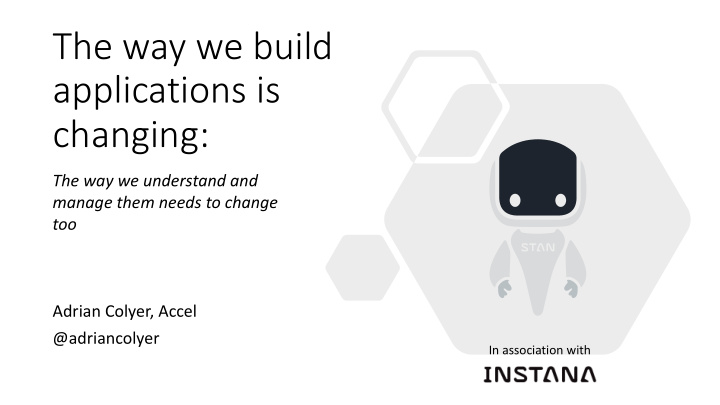



The way we build applications is changing: The way we understand and manage them needs to change too Adrian Colyer, Accel @adriancolyer In association with
Agenda • How we got here • The rules have changed • Where we’re heading…?
Some buzzwords Cloud native Kubernetes microservices serverless
Some buzzwords Cloud native Kubernetes microservices serverless
Focus on delivery of value
Optimising for throughput and latency
Things become finer-grained over time Image credit: Khan Academy, “Introduction to Integral Calculus”
Shift left
Shift left means… • In the loop, not after the loop • For the many, not the few • Taking an application/service perspective
WHERE HAS ALL THE THE RIVER COMPLEXITY GONE? Consequences EMERGENT GRAY FAILURES BEHAVIOURS
https://www.complexityexplorer.org/courses/105-introduction-to-dynamical-systems-and-chaos • Bifurcations • Randomness • Stable averages, unstable details • Complex emergent behaviours
The rules have changed
Instrument rated Image credit: “5 3 Visual Flight Rules”, Robert Kowalksi. https://www.youtube.com/watch?v=r7u 8zj9m7EU
“Embrace Complexity, Scale Agility”, Dave Snowdon 2015 https://www.youtube.com/watch?v=lYlqhvzI_VQ&feature=youtu.be
Where we’re heading…
Some challenges • Raising the level of abstraction • Rethinking design assumptions (especially relating to hardware advances) • Software supply chain • Sustainable OSS • Increasing automation • Interpretability • Bias and Fairness • Operating at the limits
Image Credit: Wikipedia (public domain)
See also: “Above the Line, Below the Line”, Richard I. Cook, M.D., ACM Queue Vol 17, Issue 6
APM as a sense- making instrument STAN as a ‘team player’
Thank you. acolyer@accel.com @adriancolyer
Q&A
Selected Resources • Project to Product , Mik Kersten, 2018 • Resilience Engineering in practice , Hollnagel et al, 2010 • Value Stream Mapping , Martin & Osterling, 2013 • Ironies of Automa tion, Bainbridge 1983 • Accelerate State of DevOps Report , • Ten challenges for making automation a Forsgren 2019 team player in join human-agent activity, Klein et al., 2004 • Cynefin framework, see e.g.: Embrace Complexity, Scale Agility , Snowdon 2015 • Trade-offs under pressure: heuristics and observations of teams resolving internet • Introduction to dynamical systems and service outages , Allspaw 2015 chaos, Sante Fe Institute ‘Complexity Explorer’ • STELLA: report from the SNAFU-catchers workshop on coping with complexity , • Above the Line, Below the Line , Cook Woods 2017 2020 • Gray failure: the achilles heel of cloud- scale systems , Huang et al., 2017
Recommend
More recommend